I got one, havent tried yet, but If I dont recall badly it Said a adjustable XO from 80hz-500hz, but I dont know If its a low pass for the subwoofer or high pass for the satellites, o maybe both, as it has four pots... If I have the time during the week, I Will try it and try to figure it out... And post it...
Yes please try it Danzz - if it works out that is a lot of amp for $27. My guess is that the 4 pots are: master vol, sub volume, sub xo freq, treble ?
I noticed that these 2.1 boards still use only a single power input. Has anyone noticed sag in voltage when running tops and bottoms at sustained higher powers? You can't get 200 watts from 19v brick SMPS. Even with Meanwell 6a unit maybe 120 to 150 watts.
Thanks in advance.
Question...I tried searching this thread first but couldn't find it...is the Bass volume ganged to the master volume on the 2.1 board?? Or is it that every time you adjust the master volume one has to adjust the bass output as well??
Thanks!!
Thanks!!
I don't know for sure - Danzz will have to tell us but I think the bass volume should be relative to the main volume otherwise that might be annoying to adjust.
New Yuan Jing 2.0 TPA3116D2 Amp: First Impressions
Wow! This sounds really nice. I have a faint buzz that I suspect comes from the long hookup cable that came with the amp. My speaker binding post connections should be shortened as well. When playing music, I don't hear it, but it bugs me because I'm OCD about noise in my system. I may need to add my own custom-made shielded cables later on, but just wanted to listen to it in stock form first. Compared to my most recent Sure Electronics TPA3110D2 build, the soundstage is deeper with more space between musicians, the imaging seems to be well focused, the bass is deeper and it sounds warmer to me than my modded TPA3110D2 Class D and TDA7297 chip amps. Keep in mind, this is only based on some limited listening on SACDs and CDs I am very familiar with. I really have to give this amp more time and listen to more music to make a call in this, but I think this amp is very promising in stock form.
One thing to note is that they have the left channel connections labeled as right channel and vice versa, but it's nothing like feeding the right input and getting the output on the left channel. The channels are consistent, they are just mislabeled. At least the power supply terminal connections are properly labeled. I checked those before plugging the amp in.
I am using my trusty modified Power One SMPS set at a 12.5V DC / 6A output. I don't think I'll need more power than this for my 98dB Klipsch Forte IIs unless someone really convinces me that I need to upgrade to more power.
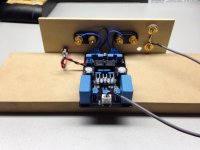
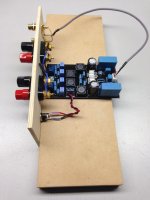
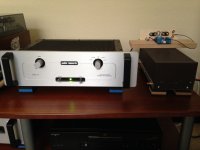
Wow! This sounds really nice. I have a faint buzz that I suspect comes from the long hookup cable that came with the amp. My speaker binding post connections should be shortened as well. When playing music, I don't hear it, but it bugs me because I'm OCD about noise in my system. I may need to add my own custom-made shielded cables later on, but just wanted to listen to it in stock form first. Compared to my most recent Sure Electronics TPA3110D2 build, the soundstage is deeper with more space between musicians, the imaging seems to be well focused, the bass is deeper and it sounds warmer to me than my modded TPA3110D2 Class D and TDA7297 chip amps. Keep in mind, this is only based on some limited listening on SACDs and CDs I am very familiar with. I really have to give this amp more time and listen to more music to make a call in this, but I think this amp is very promising in stock form.
One thing to note is that they have the left channel connections labeled as right channel and vice versa, but it's nothing like feeding the right input and getting the output on the left channel. The channels are consistent, they are just mislabeled. At least the power supply terminal connections are properly labeled. I checked those before plugging the amp in.
I am using my trusty modified Power One SMPS set at a 12.5V DC / 6A output. I don't think I'll need more power than this for my 98dB Klipsch Forte IIs unless someone really convinces me that I need to upgrade to more power.



Ha ! I was busy today with drilling etc. the case for the same amp. Good that you are glad with the sound quality. I just started encasing it as I thought it would be a good one anyway... I ran across very nice medical R-core transformers with static shield that I will use for this one.
It seems they have a problem with left and right at Yuan Jing, just like the chinese government 😉 They make nice amps though.
It seems they have a problem with left and right at Yuan Jing, just like the chinese government 😉 They make nice amps though.
Last edited:
Ha ! I was busy today with drilling etc. the case for the same amp. Good that you are glad with the sound quality. I just started encasing it as I thought it would be a good one anyway... I ran across very nice medical R-core transformers with static shield that I will use for this one.
It seems they have a problem with left and right at Yuan Jing, just like the chinese government 😉
Jean-Paul,
Please share photos of your build. R-core transformers with a static shield sounds like a nice and quiet power supply in the making.
I recently installed new tested and matched JJ E88CC/6922 tubes in my ARC LS7 line stage and this combination sounds really good for now. If I get the itch to roll caps, I might install some Wima MKP10 caps along with either Panasonic FM or Elna Silmic II caps, but I'll leave this alone and enjoy the music. I am going to fire up the ARC PH5 phono stage and listen to some vinyl later today.
Too dark here right now but I will do later on. The R-core is 45 W but I won't turn the amp loud so I guess it will be OK. If not I will replace it for a toroid.
Looks like we have a winner here with the Danzz Blueboard Special🙂
I want the get this amp too but still waiting for my green ones (forget what they are called) to arrive.
Edit: just looked at the cheat sheet. I waiting for 2.0 Ybdz to arrive.
I want the get this amp too but still waiting for my green ones (forget what they are called) to arrive.
Edit: just looked at the cheat sheet. I waiting for 2.0 Ybdz to arrive.
Last edited:
Too bad they have made the third mounting hole very close to the resistors and at the bottom of the PCB a metal standoff can cause the metal chassis to make contact with the GND plane. Since I always use floating audio GND and only the case connected to PE I will have to use plastic standoffs.
Keep in mind that if you use a open frame switcher you will have a ground loop when PE is connected ! Also keep in mind that 99.9% of open frame switchers definitely need a PE connection for safety. So there is a large possibility for ground problems when using a metal case, a switching PSU and an amp with audio GND connected to the chassis. I leave the thinking to you as it is very good to understand this problem and know why things can go wrong.
Keep in mind that if you use a open frame switcher you will have a ground loop when PE is connected ! Also keep in mind that 99.9% of open frame switchers definitely need a PE connection for safety. So there is a large possibility for ground problems when using a metal case, a switching PSU and an amp with audio GND connected to the chassis. I leave the thinking to you as it is very good to understand this problem and know why things can go wrong.
Last edited:
Thanks for the preliminary write up on this board.
I ordered 4 of them last week ( two for me and two for a bud ).
I'm looking forward to trying these things out for myself.
John
Addendum: The mislabeling on the board is consistent from end to end? In other words if I put the left input on the left side ( facing the input ) and the right input on the right, the output will be on the same side at the other end of the amp regardless of label?
I ordered 4 of them last week ( two for me and two for a bud ).
I'm looking forward to trying these things out for myself.
John
Addendum: The mislabeling on the board is consistent from end to end? In other words if I put the left input on the left side ( facing the input ) and the right input on the right, the output will be on the same side at the other end of the amp regardless of label?
Last edited:
Im glad that this "blue amp" it sounds good, that means that my design was not far from being good!!!...
Yes, nice work! Just a question: did you consider an anti-bump solution in your design?!
No, in fact I followed the TI schematic, didnt consider it
Im glad that this "blue amp" it sounds good, that means that my design was not far from being good!!!...
Ey, don't exaggerate. You can do better 😀
No, in fact I followed the TI schematic, didnt consider it
I think they copied that as well, the lack of anti-thump that is. Nothing is perfect...
Last edited:
Spinning vinyl now and feeding the signal through my tube phono stage and tube line stage amps connected to the YJ blue board. This is sounding better as it plays on. I've noticed this break-in with other Class D amps I've owned. The sound is impressive as this amp sounds "bigger" than my Sure Electronics TPA3110D2. The available headroom, even with a 12V DC / 6A SMPS is impressive to say the least. It almost has a quasi-bloom like a tube amp if I can describe it that way. Maybe it's just the tube bloom from the amps in front of it.
One thing to note is that they have the left channel connections labeled as right channel and vice versa, but it's nothing like feeding the right input and getting the output on the left channel. The channels are consistent, they are just mislabeled. At least the power supply terminal connections are properly labeled. I checked those before plugging the amp in.
Unless they have changed it, the one they show in their website it looks ok, looking at the front of the imput side Rin should be on the left GND in the middle and Lin at the right, and if you look the output side the the left output should be on the left and right on the right. To make it easier Both, Rin and Rout are in the same side as the power supply input.
if you follow the tracks from the big input caps to the TPA3116 IC you should have the Rin conected to pin 4, and Lin to pin 10.
I think what its wrong could be the connector they sent.
Unless they have changed it, the one they show in their website it looks ok, looking at the front of the imput side Rin should be on the left GND in the middle and Lin at the right, and if you look the output side the the left output should be on the left and right on the right. To make it easier Both, Rin and Rout are in the same side as the power supply input.
if you follow the tracks from the big input caps to the TPA3116 IC you should have the Rin conected to pin 4, and Lin to pin 10.
I think what its wrong could be the connector they sent.
With all the amps I've worked on and own, the left channel is always on the left and the right channel is always on the right when facing the front of the amp. Otherwise, you are crossing your speaker cables and interconnects. This arrangement that Yuan Jing has printed on the board is reversed from the convention I am used to, so I just ignored it and it's fine.
I made some shielded cables using Mundorf Silver-Gold wire, Tinned Copper braided shielding, Teflon tubing, Teflon tape and heat shrink. I reused the 3-pin connector to allow for easy connect/disconnect until I determine what my final build will be. The noise floor has further decreased. I can't tell if it sounds better or not, but it definitely still sounds great.
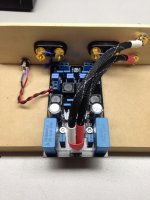
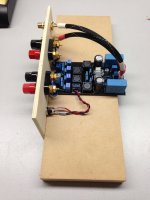
Hey guys, looking to get into the TPA3116 fun. As of February 16, 2014 is the Danzz designed version the best version of this so far, at least for the price?
Yuan Jing Audio - ON SALE! - TPA3116 Class-D 2.0 Stereo Amplifier Board [50W+50W] - $19.99
Yuan Jing Audio - ON SALE! - TPA3116 Class-D 2.0 Stereo Amplifier Board [50W+50W] - $19.99
I can only compare it to the original YJ 2.0 (although the Feixang is on its way, finally), but of those two, no question, the Danzz board is a very real improvement and will be much easier to work on if you do decide to swap bits.
I would much rather have the option to put in a better pot/attenuator and to not be limited by the location of the board-mounted pot when putting the amp into an enclosure, so it is a winner there also.
All of that said, the original board is a great amp and I would not feel the need to rush out an replace it if you already have one. I am still playing with the ones I have and enjoying them immensely.
I would much rather have the option to put in a better pot/attenuator and to not be limited by the location of the board-mounted pot when putting the amp into an enclosure, so it is a winner there also.
All of that said, the original board is a great amp and I would not feel the need to rush out an replace it if you already have one. I am still playing with the ones I have and enjoying them immensely.
Addendum: The mislabeling on the board is consistent from end to end? In other words if I put the left input on the left side ( facing the input ) and the right input on the right, the output will be on the same side at the other end of the amp regardless of label?
That is correct.
Im glad that this "blue amp" it sounds good, that means that my design was not far from being good!!!...
Your design is very good. Thank you for your efforts. You and others here did 90 percent of the design work for Yuan Jing.
Last edited:
- Home
- Amplifiers
- Class D
- TPA3116D2 Amp